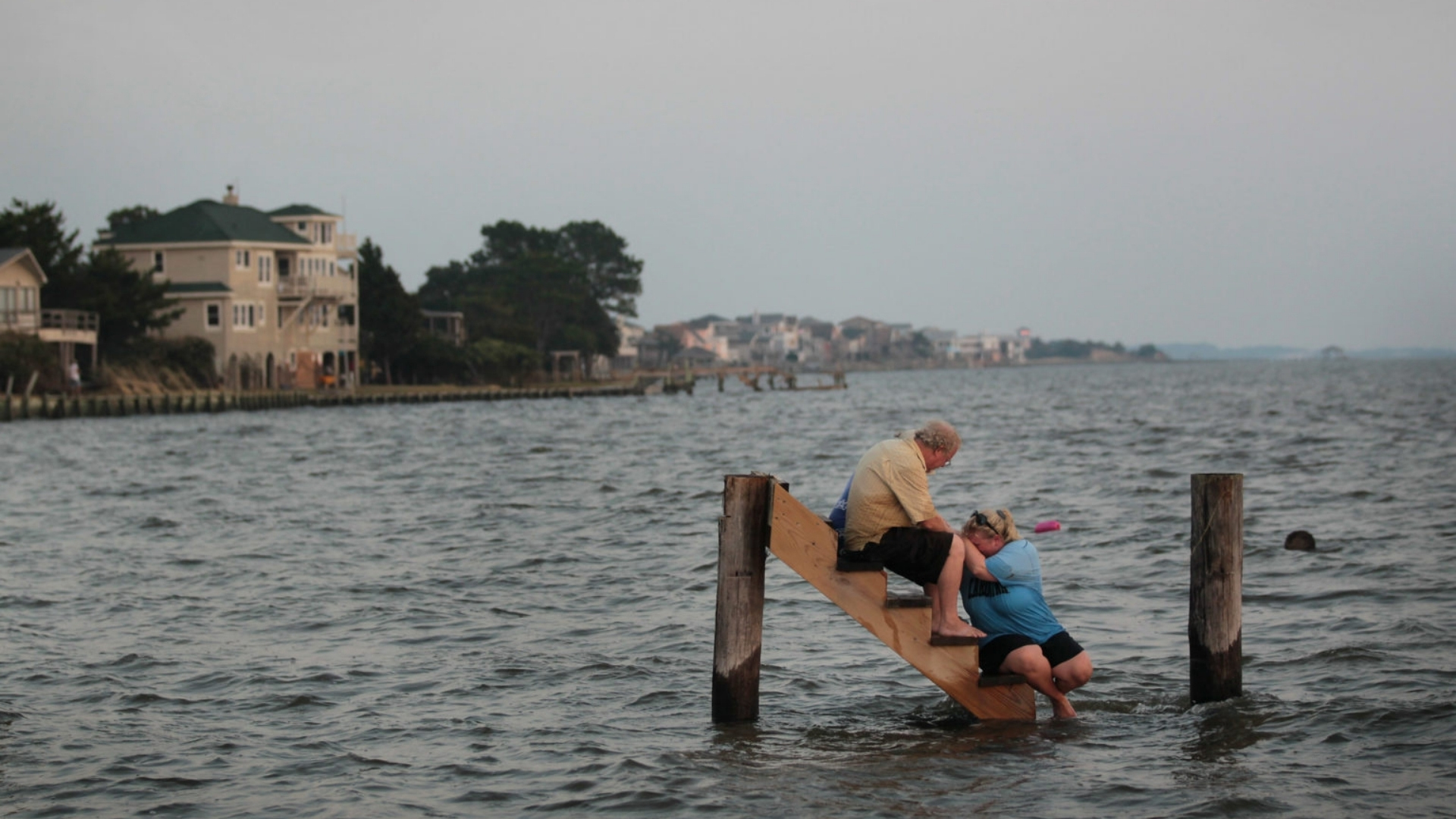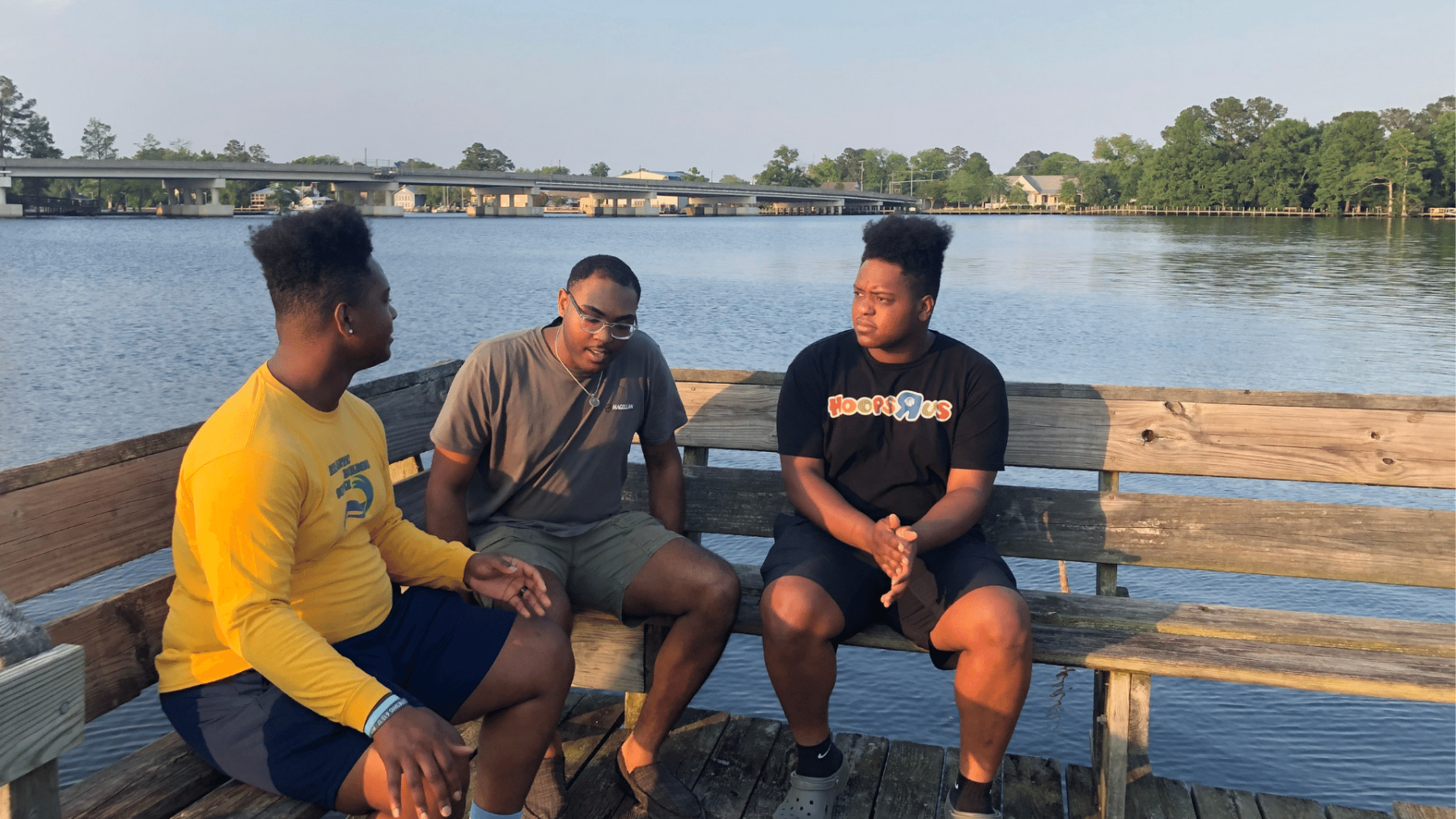
Scott Olson/Getty Images
North Carolina’s notorious climate change law — the rich are ok, the poor aren’t
Driving through Tyrrell County on the eastern coast of North Carolina, the impacts of climate change are clear.
Roads flood regularly, cutting off people in isolated areas from their jobs, schools and basic necessities. Hurricanes and powerful storms are frequent, the most recent being Tropical Storm Claudette in June. The county sits at sea level and is surrounded by water on two sides — the Albemarle Sound to the north and the Alligator River to the east.
Saltwater intrusion is dramatically shaping the environment and its economy. Acres of forests and farms are being replaced by grassland.
“These are the ghost forests,” said Willy Phillips, pointing through the window of his rumbling white truck towards haunting fields of dead pine trees. “Forests that give in as the sea level rises. Gradually, it becomes uninhabitable for them.”
Phillips has been a fisherman on the North Carolina coast for most of his life. Now 71, he runs a crab fishing business and sells his catch at Full Circle Crabs. His store is located in Columbia, the largest town in the county. “Our blood is as close to sea water as you can get,” he told me.
Phillips has also been involved in environmental issues on a state and local level for years.
“Adaptation is the key,” he said. “You have to be nimble, you have to be quick, and you have to recognize the signals.”
But nine years ago, North Carolina lawmakers took action that scientists and climate activists worried would undermine the state’s ability to respond to environmental change.
A 2010 report by scientists at the state Coastal Resource Commission predicted that sea level would rise 39 inches over the next 100 years, threatening more than 2,000 square miles of coastal land. Conservative lawmakers and real estate interests took issue with those findings. In 2011, Republican State Representative Pat McElraft introduced House Bill 819, which limited government agencies to using only historical data on sea level rise when drafting development policies and regulations.
The bill was widely criticized as being anti-science and suppressing important information on climate change. North Carolina was ridiculed on the national stage. Jokes on the satirical news show “The Colbert Report” particularly stung. “If your science gives you a result you don’t like, pass a law saying that result is illegal,” said host Stephen Colbert in a 2011 episode.

The expectation was that HB 819 would be disastrous for North Carolina’s climate adaptation efforts. However, by the time the bill became law in 2012, it was significantly weakened. The version that remains in effect today allowed the state to account for future projections of accelerated sea level rise — a major sticking point in the original draft.
According to Jessica Whitehead, former chief resilience officer at the North Carolina Department of Public Safety, “When you look at the long-term impact, there wasn’t one.”
Nearly ten years after it was passed, HB 819 serves as a rosetta stone of the contradictory strands of climate change policy in America. The law, born of political grandstanding and based on the partisan repudiation of scientific evidence, turned rising sea-levels into a politically charged subject. But while local officials in wealthy towns have found creative ways to simply work around the law and invest in climate-resistant infrastructure, poorer towns have suffered from a shortage of resources and lack of public conversation that could push local officials to prioritize climate adaptation.
As a consequence, the global dynamic of climate change — where the world’s poorest nations and communities are disproportionately affected — has been replicated in two neighboring towns in North Carolina.
Life goes on
The small town of Nags Head sits along the Outer Banks, a chain of islands that buffer the North Carolina coast against the Atlantic Ocean. It’s the kind of resort town where Mayor Ben Cahoon rides his bike — complete with “Mayor” license plate — everywhere. Given its tourist spot status, there is a general awareness that climate change, erosion and flooding could cause significant harm to the economy.
HB 819 limited how the state’s Department of Coastal Management could account for sea level rise in its planning, but it did not stop local governments from addressing the issue however they saw fit.
“That’s why Nags Head had the complete freedom to explore all these neat projects that we’ve been able to do,” Cahoon told me, sitting outside the cafe where he grabs coffee every morning.
Nags Head, with a population of roughly 3,000 people, was building towards climate adaptation before the advent of HB 819. Since 2012, it has improved canals that drain into the ocean and invested in beach nourishment, which adds sand to the shore to protect against erosion. It also adopted new local elevation standards in 2020, exceeding state regulations, which require buildings to be 12 feet off the ground on the oceanfront and nine feet elsewhere, regardless of whether the location is in a flood zone. Towns up and down the coast have also raised local elevation requirements.
The town’s approach to resiliency centers on creating systems that can be replicated in the future, Cahoon explained. He points to the outfalls where water from around the town collects to empty into the ocean. Local authorities increased the capacity of one of these drains and have established a process to do the same to the remaining ones, if necessary.
Located in one of the wealthiest counties in the state and with a municipal budget of nearly $26 million for the current fiscal year, Nags Head has plenty of resources to devote to climate adaptation, often with the support of grants.
HB 819 did manage to influence public opinion in North Carolina. Shortly after the law was introduced, sea level rise became a charged subject. “It was like a dirty word. Don’t talk about it. Don’t touch it with a 10-foot pole. It was so politicized and too volatile,” said Holly White, who became the principal planner of Nags Head in December of 2014, referring broadly to communities across the state.
Still, Nags Head has found a way to address these concerns, and resistance to discussing sea level rise has dissipated. In 2015, three years after HB 819, former mayor Robert Edwards pushed the town to participate in a vulnerability, consequences and adaptation planning scenario (VCAPS). The program is run by research agencies and facilitates community outreach and climate resiliency preparation. Throughout a two-day workshop and follow-up interviews, about 60 residents described the environmental issues they saw around the island, from drainage problems to beach loss.
The process offered a valuable lesson on how to frame adaptation projects in a way that resonates with the community. Instead of focusing on the cause of the town’s problems — sea level rise — Nags Head officials opted to place the emphasis of the conversation on consequences that people could see all around them.
“When you go into a neighborhood to solve a flooding problem that we believe is caused by sea level rise, you don’t have to go into that neighborhood and talk about sea level rise,” explained Cahoon, who has been in office since 2017. “You say ‘I’m from the government, I’m here to help you, and we’re going to solve your flooding problem.”
“That’s what citizens really care about,” he added. “Is your problem solved?”
On the western side of Nags Head, across town from the ocean, undeveloped marshland stretches out a couple of hundred yards into the Roanoke Sound. Shallow islands of vegetation dot the water offshore. Over the years, the marsh has receded, making properties along the sound more vulnerable to flooding. Nags Head has plans to build a living shoreline, designed to be more environmentally friendly than the concrete embankments that have traditionally protected homes from the waves.
Building up this brackish stretch of land will better mitigate erosion and high waves during storms, but it also makes the area more resilient to sea level rise. It will be one of Nags Head’s most ambitious climate adaptation projects and is popular among residents. Rather than focusing on sea level rise specifically, the conversation with the community has addressed resiliency in broad terms.
Waiting for the flood
In the low-lying neighborhood of Goat Neck in Tyrrell County, about 45 minutes from Nags Head, the response to sea level rise has been very different. Tucked deep in the woods and surrounded by marshes, Goat Neck floods frequently and its residents have standing water in their yards for eight or nine months of the year. The amount of water in the ground is steadily increasing, so the land remains muddy even on a hot spring day.
“People say when sea level rises, the tide comes into the yard. No, it comes up through the yard,” said Willy Phillips, who has lived in the county for decades.
The soil is so wet that people can only bury their relatives in the community’s small graveyard during the hottest seasons, and coffins are covered in concrete to keep them from rising to the surface after they are interred.
Goat Neck, which consists of around 17 inhabited homes and several more abandoned ones, is one of the most vulnerable areas in North Carolina. However, owing to its location on the edge of the Albemarle Sound, which flows into the Atlantic Ocean, all of Tyrrell County feels the effects of environmental change.
People are accustomed to frequent damage to their houses caused by repeat flooding, so many have either built more space underneath or put ducts for heating and air conditioner units higher off the ground.
Saltwater intrusion is destroying agricultural land. Most farmers grow cash crops like corn, wheat and soybeans, which don’t do well in saline soils. Farmers are installing expensive pumps to drain excess water, but that’s a temporary solution, at best.
“It’s sort of like the finger in the dike. You’re just able to hold it back long enough to get a couple more harvest seasons out of it,” said Phillips.
Now, farmers are abandoning their fields, thereby slashing their profits. Agriculture is the largest industry in the county, but the acres of arable farmland decreased 18% from 2012 to 2017, according to the US Department of Agriculture.
Despite the obvious damage that sea level rise is causing, Tyrrell County has been powerless to react in any meaningful way. The reasons for this reflect a global trend in which the communities hit hardest by climate change are often the ones least able to do anything about it.
This inability to take action is due, in large part, to a lack of resources. Tyrrell County is one of the poorest in the state, with a median household income of around $35,000 a year — about half the national average — and 25% of its residents live below the federal poverty level of $26,500 a year for a family of four.
Many homeowners in Goat Neck don’t have the resources to elevate their houses, which sit a foot off the ground, at risk of sustained damage from rising water. Deserted trailers dot the neighborhood. The people who remain have done what they can to adapt. Philips and I passed one house that had several two-by-four planks stacked on cinder blocks, forming a makeshift bridge from the front door to the road. There was a heatwave that day and the yard was dry, but people are always prepared for the next flood.
Tyrrell County doesn’t have the money to take on the big infrastructure projects that would make neighborhoods like Goat Neck more resilient to climate change. Around 4,000 people live there now, making it the least populated county in the state, and the population has declined nearly 9 percent since 2010. As residents age and younger people move away, the tax base is diminishing, leaving the government with limited funds.
“The bottom line is when it comes back to implementing some of the things that we recommended that we do, they’re just too darn expensive,” said Rhett White, town manager of Columbia, the largest town in Tyrrell County.
As a result, county leadership tends to focus on projects that experts believe to be short-sighted, like dredging drainage canals. In Goat Neck, the canal that drains excess water into the Albemarle Sound is filled with debris, fallen trees and sediment. While clearing it could dry the ground, the ditch will eventually be lower than the water level.
“You can’t drain landscapes that are a foot below sea level,” explained Dr. Ryan Emanuel, a hydrologist at North Carolina State University.
Longer-term solutions include the installation of pumps to dry out the ground, but such measures are expensive. “Who’s going to maintain them? Who’s going to pay for the electricity or the diesel fuel to run those pumps,” said Ty Flemming, the director of the Tyrrell Soil and Water Conservation Department.
The ongoing Band Aid fixes applied in places like Goat Neck are not rooted in denial of science. They simply cannot afford to invest in climate adaptation that will adequately serve residents in the future.
Without massive financial investment, the Goat Neck community, which has existed since before the Civil War, will soon cease to exist. Recently, the county commissioner asked Phillips if he would see if residents, many of whom are older, would be willing to take a relocation buyout. Everyone he asked declined.
“They said, “We can’t leave our people in the ground.’ It’s the people in the cemetery, you know. They just can’t go,” he told me. “But sooner or later, they make their choice and they leave.”
A present-day imperative
The challenges that Tyrrell County faces in responding to climate change also extend beyond finances. There is little in the way of local conversation, or effective outreach and education. For some, it seems like the subject of rapidly encroaching environmental change is not even on the agenda.
Angus Spencer, 28, only remembers learning about sea level rise once in middle school. In 2017, he met scientists working with the nonprofit North Carolina Sea Grant and North Carolina State University, who came to town to talk about climate resiliency, but the topic hasn’t come up since.
Matt Jurjonas, an environmental social scientist, was part of that outreach effort. He explained that people in Tyrrell County know that they are vulnerable to flooding and severe storms, however, many have never seen projections for sea level rise and what it could mean for them.
“If they aren’t aware, they’re obviously not planning for it,” he said.

Spencer grew up in the county and now leads youth groups and Bible study classes at the Columbia Christian Church. He thinks there needs to be a sustained dialogue about the environmental threats the area faces.
“Even if it was just a week within the community, this is what we’re going to talk about,” he said. “But nobody has gotten to that level. There’s nobody to really start that conversation.”
Columbia’s residents appear to want to learn about environmental change. Spencer’s 19-year-old cousins Da’Shawn and Ka’Shawn told me that they have questions about climate adaptation for their elected representatives, but that there have been no community meetings where they could raise them.
But precedents for community-driven change do exist. In the past, people in Tyrrell County have successfully advocated for and secured environmental protections. Years ago, the state government wanted to build a hazardous waste incinerator in the area. Locals, including Phillips, dragged an old TV to the grocery store, set up chairs, gave out popcorn and played a short documentary about the health risks it could bring. Within days, the community united against the proposal, and the development was shelved.
To date, similar action has not been taken regarding climate adaptation. After all, it’s not a top priority for many people, said Spencer. In a poor and isolated rural area with few jobs and high unemployment, people are more focused on supporting their families today than they are on considering environmental threats that feel far in the future.
For Spencer, outreach on sea level rise and climate change needs to be framed as a present-day imperative.
“Don’t bring it to us as a want, bring it to us as a need,” he said. “‘You need to have knowledge about this, if you want this community to be able to survive and not become Atlantis.’”
Small gains
In the nine years since HB 819 was passed, the apocalyptic warnings about anti-science lawmakers setting the state back years in its response to climate change have not panned out. Sea level rise is acknowledged by the state government, including in the June 2020 North Carolina Climate Risk Assessment and Resilience Plan, which says it is “virtually certain” that oceans along North Carolina’s coast will continue to rise and that the intensity of storms will increase.
The law may have even been beneficial in a roundabout way, said Jessica Whitehead, the state’s former chief resiliency officer. In places like Nags Head, it forced state agencies and local governments to be creative about how they framed an often politically charged topic to engage as many people as possible.
“If we could just say sea level rise and run with it, in the long run, would we have lost ground?” Whitehead asked. “In terms of getting things done, I think we had to think more carefully about what do we need to get out of this. What does this really mean for people? We couldn’t fall back on scientific jargon.”
While HB 819 may have caused national outrage, the factors that have undermined the ability of communities to respond to climate change are deeper and more systemic than the edicts of anti-science politicians. Now, In Tyrrell County, even drastic action may be too little too late.
As Phillips told me, the trees in the ghost forests are “dying in parallel with the community.”
“It’s going to be under water. That’s just what’s going to happen. The county will cease to exist. There’s nobody that’s going to save Tyrrell County.”
Photos by Caitlin Thompson.
The story you just read is a small piece of a complex and an ever-changing storyline that Coda covers relentlessly and with singular focus. But we can’t do it without your help. Show your support for journalism that stays on the story by becoming a member today. Coda Story is a 501(c)3 U.S. non-profit. Your contribution to Coda Story is tax deductible.



















